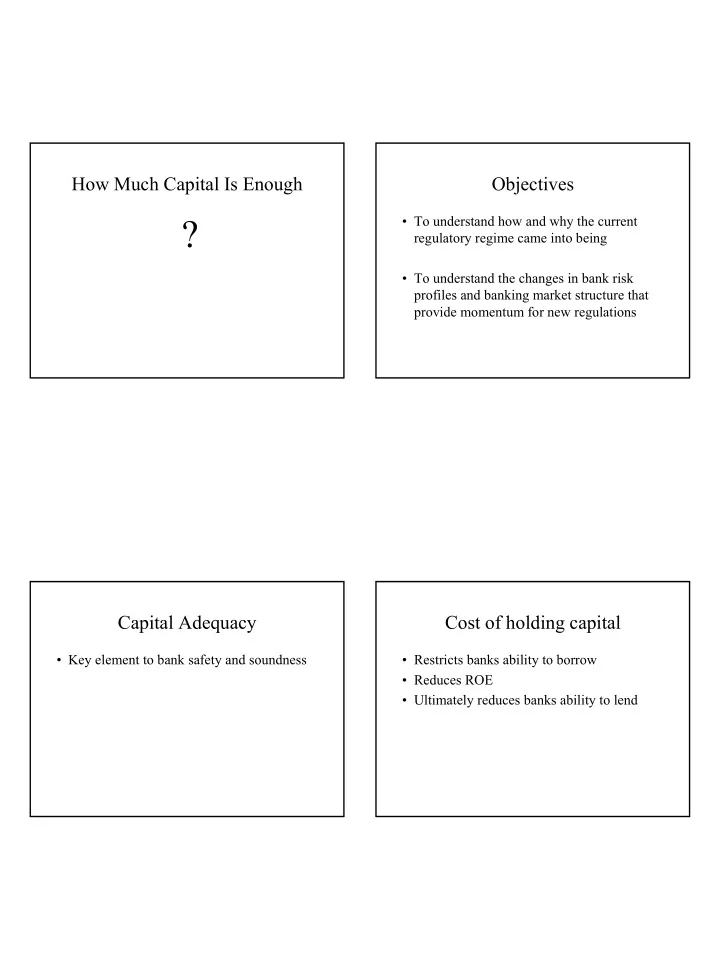

How Much Capital Is Enough Objectives ? • To understand how and why the current regulatory regime came into being • To understand the changes in bank risk profiles and banking market structure that provide momentum for new regulations Capital Adequacy Cost of holding capital • Key element to bank safety and soundness • Restricts banks ability to borrow • Reduces ROE • Ultimately reduces banks ability to lend 1
Historical Context Historical Context • 1864, National Bank Act set static minimum capital requirements based on • Judgment based, subjective bank-by- population of banks service area bank approach • Example: 1954 American Bankers • Franklin National bank (1974) and First Association statement f principles rejected Pennsylvania Bank(1980) were relatively numerical formulas for determining capital large banks that failed adequacy 80’s 80’s •1983, Congress passed International Lending and Supervision Act (ILSA) directing federal banking • 1981, Federal banking agencies introduced agencies to issue regulations addressing capital explicit numerical regulatory adequacy. requirements •1985 uniform capital requirements • Minimum primary capital adequacy ratio of 6 percent for community banks and 5 • Minimum primary capital for: percent for larger regional institutions. –Large banking organizations increased from 5 • Threshold capital-to-assets ratio of 6 percent to 5.5 percent of adjusted total assets percent and minimum ratio of 5 percent –Community banks’ capital requirements fell from 6 percent to 5.5 percent 2
80’s Cont. Basel Accord • 1986, Concern that the primary capital ratio failed to differentiate among risks and did not provide an accurate measure of • 1988, the central bank governors of the the risk exposures Group of Ten (G-10) countries adopt the Basel Accord • Regulators began to study the risk-based capital framework of other countries • Under Accord, U.S. assets and off-balance- items are “risk-weighted” based on their – France-1979 perceived credit risk using four categories – UK-1980 • Risked based capital framework remains – West Germany-1985 in effect today Credit Risk Categories Basel I Capital Requirements • Most claims are weighted at 100 percent • Residential mortgages are weighted at 50 percent • Claims on or guarantees provided by qualifying banks and other entities are weighted at 20 percent • Very low risk, such as those guaranteed by qualifying government are weighted at 0 percent 3
Prompt Corrective Action Bank Capital Levels • U.S. depository institutions are subject to PCA regulations, institutions are classified into categories based on their regulator capital ratios • Highest capital ratios classified as “well capitalized” • Lower capital ratios assigned lower capital categories • Less than well capitalized have restrictions or conditions on certain activates • Minimum leveraged ratio for strong institutions is 3 percent and 4 percent for other banks Results of “Risk-Weighted” Capital Growth Capital Requirements • Measured on-balance-sheet capital ratios have risen since Accord took effect in 1992 without evident contraction in credit availability • Banks seen increase not only in equity capital, but also revenues and income 4
The need for change Change in Bank Asset Mix • Blunt instrument with respect to credit-risk differentiation • Measure tends to understate true degree of credit risk in bank portfolio • To enhance ability to enforce capital adequacy bank supervisor’s need the ability to harness two tools: – Market Discipline – Risk Metrics employed by banks The need for change Reasons for New Accord • Need for Financial Transparency Regulators Financial Institutions • Keep pace with • Better aligns business – For market discipline to be effective,market financial innovation decisions with internal participants must be adequately informed about capital allocation the risks banks are taking • Better align capital methods charges with • Use of internal measures to set capital underlying risk • Potential for lower requirements for credit risk minimum capital • Promote better risk charge management 5
Basel II Framework Basel II Three Pillars • Will include more risk buckets to provide enhanced risk sensitivity • Will rely on on external ratings agencies to Pillar 1: Pillar 2: Pillar 3: help determine risks Minimum Supervisory Market Capital Review Discipline • Internal ratings based (IRB) approach Requirements Process •Banks review Increased •Credit Risk own capital disclosure given •Operational Risk adequacy reliance on •Supervisors •Market Risk internal evaluate bank assessments assessments Difference in Capital Requirements Under Basel II, Capital Requirements Will Vary Much More With the Risk of the Borrower Minimum Capital Required for a $100 Commercial Loan of Quality: a Capital Standards in Place 1981 - Present AAA Credit Risk BBB- Credit Risk B Credit Risk Prior to 1981 Judgmental Judgmental Judgmental 1981 - 1988 (Prior to risk-based framework) $5.00 $5.00 $5.00 1988 - Present (Risk-based standards of Basel Accord) $8.00 $8.00 $8.00 Proposed Basel II Standards AAA Credit Risk BBB- Credit Risk B Credit Risk Proposed Basel II Standardized b $1.81 $8.21 $12.21 Proposed Basel II Foundation IRB c $1.41 $5.01 $18.53 Proposed Basel II Advanced IRB d $0.37 $1.01 $3.97 to to to $4.45 $14.13 $41.65 6
Recommend
More recommend